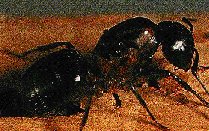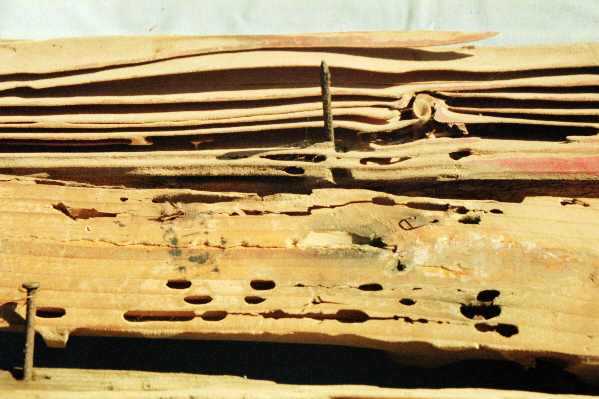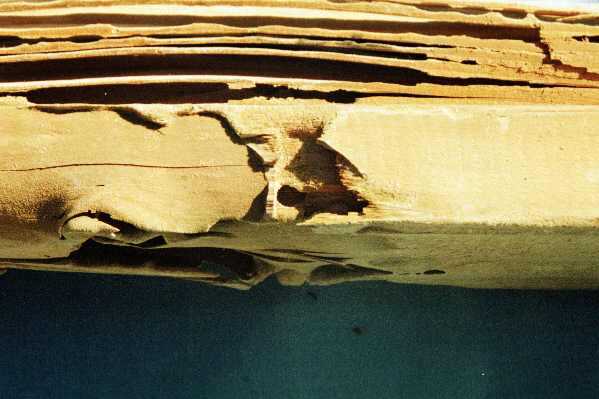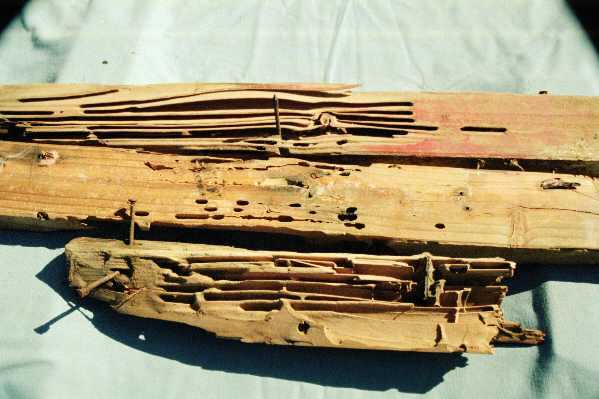
CARPENTER ANTS
Carpenter ants are the largest ants in North America. They nest in wood and can therefore cause extensive structural damage to homes. These nests, called galleries, can be located anywhere the conditions are right for infestation. |
Identification
Carpenter ants are usually black, but can also have reddish bands, or even can be all red. They are the largest species of ants in North America, but they are polymorphic, which means that they can develop into several different sizes. Therefore, size and color are not definitive identification characteristics (although large black ants are almost definitely carpenter ants). There are three parts to the ant's body; the head, the thorax, and the abdomen. Between the thorax and the abdomen, there are small bumps or spikes. Carpenter ants have only one spike. This is the first identification characteristic to look for. |
| Another thing to look for is the damage that is caused by carpenter ants. The first thing to look for is Frass. Frass is a sawdust type material that the carpenter ants remove from their nesting area. This frass usually has some insect parts mixed in, because carpenter ants feed on insects.
Also nearby would be the galleries, or tunnels, that the carpenter ants actually live in. These may be more difficult to locate, unless you are doing remodeling work. However, sometimes this can be located in the basement by poking around with a screwdriver. Also, windows, which are places where the carpenter ants broke through the outer surface of the wood either accidentally or for access out of the galleries. |



|
|
Click on damage images for a larger image and description! | |
| Of course, the presence of the carpenter ants themselves is the most important identification tool. These ants may or may not have wings. In late spring and early summer, the carpenter ant nests will swarm. This is when Swarmer Ants (these are the ants with wings) leave the nest to set up new nests. These are the future queens of new nests. The old queens still stay in the old nests. In fact, it is estimated that the queen can survive up to 25 years. The presence of swarmer ants indicates that the nest is mature and has been in existence for several years. |
Conducive Conditions
Carpenter ants require a large amount of moisture in their nesting areas. Outside, that usually is no problem. They find a rotten log or timber and nest in it. However, in the middle of the summer, when it gets hot and dry, the wood they are nesting in outside dries up. They will begin to look for other nesting sites. Since we have water running through our home, even the condensation on the pipes may be enough moisture for the ants. This is when 90% of the carpenter ant infestation enters someone's house. The entire nest can be moved into the home. I have had numerous calls in July and August where the customer said their house is being attacked by long lines of ants marching in. Sometimes, this invasion is temporary, and sometimes it becomes permanent. |
Control and Prevention
The first thing that needs to be done is to eliminate conducive conditions. Although condensation on pipes may be enough moisture for carpenter ants, they usually look for wood with heavier moisture content. Any leaking pipes need to be fixed, wet rotting wood should be replaced, and adequate moisture control techniques such and ventilation and sealing should be pursued in the attics, basements, and crawl spaces in buildings. SEE MOISTURE CONTROL for more information on this. Also any wood contacting the ground should be removed or cut back. Finally, firewood should not be placed in or next to the structure. |
| Sometimes, even without visible conducive conditions, the homeowner should use pesticides to eliminate the potential infestation of carpenter ants. I highly recommend a liquid based pesticide, of course labeled for carpenter ant control. I would stay away from powders and granules because they tend to wash away with the first rainstorm. Baits have not worked well in the past because the carpenter ants diet (insects) cannot be duplicated appropriately enough to be effective. Liquid sprays can be sprayed on the exterior foundation, under the siding, under doors and around garage doors. |
| If ants are nesting inside the structure, then you will need pesticide products that are not available to the consumer. This is when you will need to hire a pest management professional. |



